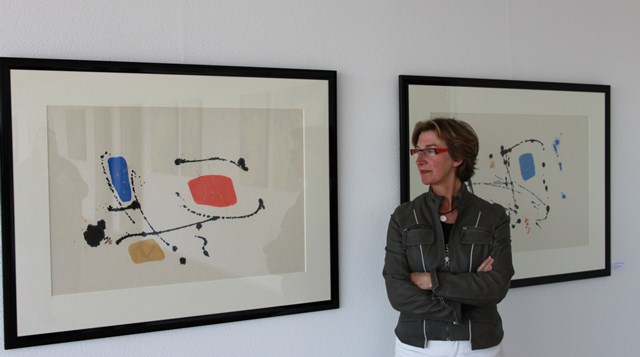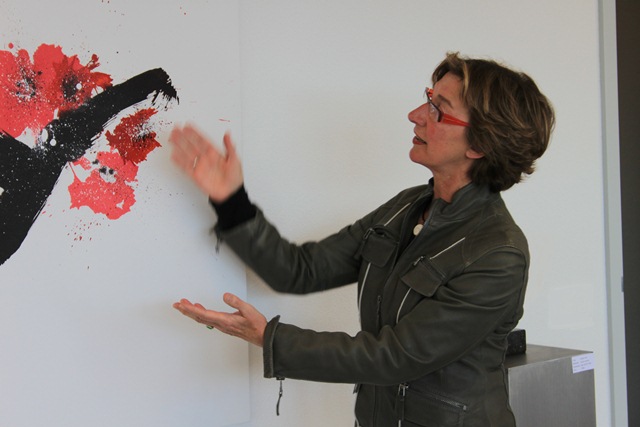Interview
You took up Sumi-e painting in 1985. What attracted you to this art form?
I “fell” for the beauty of the materials used in Japanese ink painting, when I first saw rice paper in the shop window of a stationery shop. At the time, I had no intention of using it for painting – I just needed it for design purposes. Yet, the materials seemed to “call” me. Eventually, this “call” became so strong that I decided to take up painting. My Japanese teacher quickly noticed that I had a natural talent, particularly in the zen style. “The qualities you have must be innate, they cannot be learned,” she said.
In later years, this was confirmed regularly by other Japanese people and by Zen Buddhists. That is the reason why I was given the title of Sumi-e Master when I was in Japan in 1990. I always say, “I did not choose this art form, this art form chose me.”
What characterises your work?
Simplicity, spontaneity, directness and emptiness. But in particular simplicity. Simplicity is the mark of truth. I always try to capture the true essence of things. This can only be accomplished if you are courageous and able enough to leave things out. Or rather, make use of the emptiness. As a well-known Japanese Master recently said about my work:
“There is no difference between a Japanese Master and her.
This is unique outside Japan, I can hardly believe it!
She has a perfect eye for balance and composition.
This innate ability cannot be taught.
She knows when to stop striking her brush.
Marjon’s use of ink is restrained.
She allows the emptiness to occur and she gives it space.
Her work shows her gratitude for the true art of creation.
This is also a sign of modesty.”
How would Japanese people describe your work?
Japanese people think my working methods are innovative and refreshing. They find it particularly interesting that I have the ability to make typically feminine paintings, i.e. subtle and refined, but also typically masculine paintings, i.e. powerful and robust. The combination of these two elements in my work is what appeals most to them, especially since they do not combine feminine and masculine elements themselves. The fact that my work possesses both power as well as grace is considered to be unique. There is also great appreciation for the very professional manner in which I highlight and portray this traditional art form of ink painting in the West, especially since it is more or less dying out in Japan.
What materials do you use?
For Japanese ink painting (Sumi-e) I use original, high-quality materials from Japan. These materials are only available in Japan. The ink consists of compressed charcoal sticks mixed with animal-based glue. This stick (Sumi) is rubbed on an ink stone (Suzuri), thus creating a black emulsion. This is then diluted with different amounts of water to create shades of grey. I use special Japanese brushes (Fude) which may contain one or more types of hair selected from sheep, badger, horse, wolf, and goat. I paint on Japanese paper (Washi), also known as rice paper. It is available in many variations. The desired effect is achieved by the right combination of ink, brush, and paper. All my paintings contain a seal – this is my Master’s mark. Seals are carved from a special type of stone. They are lubricated with seal paste and then printed on the painting. The most beautiful seal paste is made from raw silk and cinnabar (red dye). Besides Sumi-e I paint canvases in acrylic paint, also in “Japanese style”. That is, I use the acrylic paint in a very transparent way.
 Who and what inspires you?
Who and what inspires you?
First of all, nature in all its beauty, where all forms exist. And silence - silence is absolutely essential to me. If you are open to silence, you will experience and even hear it in everything. I can even hear the silence of a waterfall. I once wrote this short poem:
“In silence lies the answer
In silence you connect
In silence there is wisdom
Give silence your respect”.
In addition, I also find inspiration in spiritual teachings, particularly Buddhism, Taoism, and the pure teachings of Jesus.
How would you describe yourself as an artist?
I am an artist pur sang. I am also a loner, I go my own way in everything I do. I have always had a desire for beauty. This desire appeared in my early childhood, which was hard and traumatic. Back then, I used to be locked into my own world of beauty, thus changing my reality. I see beauty in everything, up to the tiniest things and the smallest detail. Every time I start to paint, I have a beginner’s mind. There are no assumptions, no musts, and no goals. This enables me to freely connect to creation, the creative process which flows through me by itself and often comes as a surprise, even to me. How humble does that make me feel, and how grateful.
How would you prefer your art being seen?
In my work and technique, it is often difficult to see how much work went into it. That is why people tend to think it is quite easy to do, but this is by no means the case. In order to capture the essence of an object, painting must be done quickly and efficiently. It is crucial how much pressure is applied to the brush. This process requires maximum brush control, concentration, and efficacy, so that the shades can all be painted in one stroke, thus creating depth and perspective. The actual, ultimate brush stroke takes much less time than the preparation. There are no second chances in Sumi-e. When a painting is finished, it has to be mounted. This is a difficult and tedious precision work, and an art to itself in Japan. I have studied and mastered the art of mounting paper. It is wonderful to do and also wonderful to see how paintings gain intensity by stretching the paper fibres. All in all, I would prefer people to appreciate the beauty of a single brush stroke on that beautiful paper, and the simple beauty wherein the truth lies. When people look at my art, I want them to See. Indeed, Seeing is so much more than looking… that is true perception.


